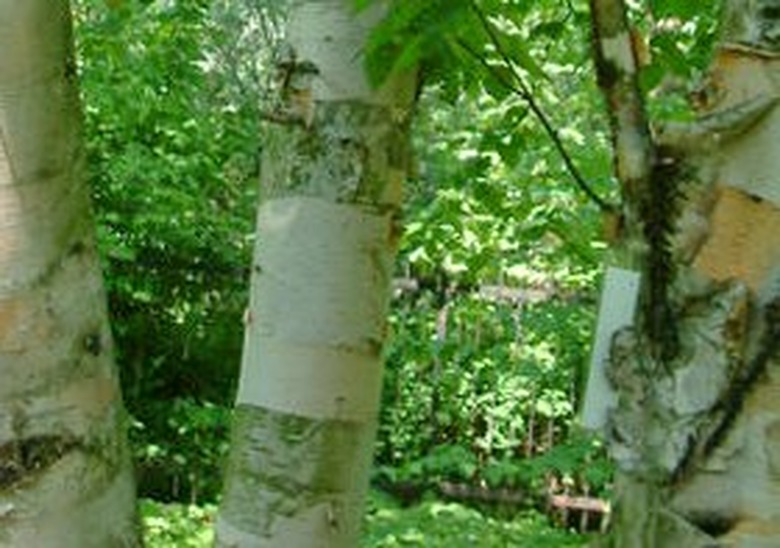How To Prune Paper Birch
Things Needed
- Pruning shears
- Pruning saw
- Pole pruner
- Gloves
- Eye protection
- Bleach or rubbing alcohol and water
- Bowl or bucket
- Sponge or clean cloth
Tip
Don't use wound dressings on pruning cuts. A proper cut encourages the branch collar to close over the vulnerable parts of a cut, and wound dressings keep the collar from closing properly. Clean pruning tools before and after use with a solution of 10 percent household bleach or 70 percent rubbing alcohol and water to avoid spreading viruses.
Warning
Do not stand on a ladder to trim trees. Always wear eye protection when pruning.
Paper birch is native to northern parts of the U.S. and is known for its white, wrapped bark, used by native people for canoe covering and writing paper. Pruning this short-lived but attractive member of the birch family is often a contest of timing with the bronze birch borer, an insect responsible for frustrated landscapers and disappointed homeowners from Maine to the mountains of the Southwest. Paper birch with enough moisture in the right location only occasionally needs a bit of pruning.
Step 1
Thin before pruning. White birch is a native species that reproduces prolifically in areas with open sun and cool, moist soils. In its natural habitat, it can live 80 years and grow 50 feet tall. A paper birch used for landscaping may live for 20 or more years if it is mulched and watered properly. Trees that receive hot afternoon sun, are located under power wires or that grow in wet or compacted soils should be thinned to draw attention to better-situated birches.
- Paper birch is native to northern parts of the U.S. and is known for its white, wrapped bark, used by native people for canoe covering and writing paper.
- A paper birch used for landscaping may live for 20 or more years if it is mulched and watered properly.
Step 2
Prune white birches before May 1 or after August 1 to avoid the "flight season" of the bronze birch borer. Females are drawn to fresh tree wounds, and wound dressings do not repel insects. Although white birch is one of the birches least susceptible to this insect, pruning in fall or winter lessens exposure to this fatal infestation.
Step 3
Prune to maintain shape, but never remove more than 25 percent of the canopy of the tree. The white birch is usually self-pruning, but branches should be removed to maintain a single trunk. Severe "Y" splits may break in a high wind; one side of the Y should be sacrificed to avoid a split.
Step 4
Clean off branches that cross or form clusters on trunks when they are young; they provide temptation for deer and other grazing animals. Branches start all along the trunk, sometimes in clusters of three or more, sometimes just a foot or two off the ground. In addition to providing leaves to graze on, these branches teach animals to return to the tree in winter when they can kill the tree by stripping the protective bark all around the trunk.
- Prune white birches before May 1 or after August 1 to avoid the "flight season" of the bronze birch borer.
- In addition to providing leaves to graze on, these branches teach animals to return to the tree in winter when they can kill the tree by stripping the protective bark all around the trunk.
Step 5
Prune dead branches promptly. Your white birch will show you which branches need removal as it ages. Always double-cut branches with a diameter greater than 2 inches to avoid damage to the "branch collar," the "wrinkled" bark around the juncture of the branch and trunk. Saw upward a few inches out from the collar, and then saw downward next to the collar all the way through to remove the branch.
